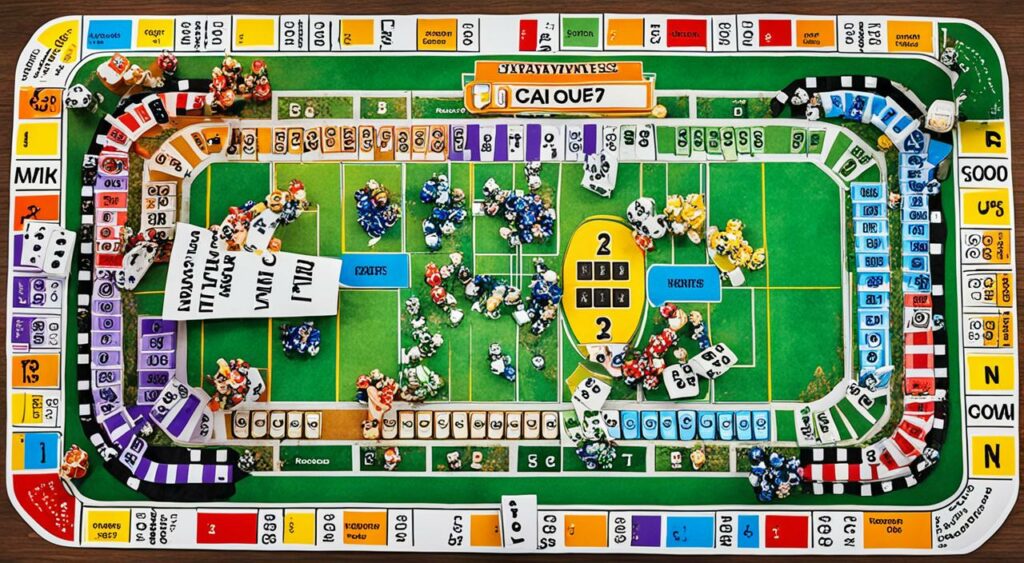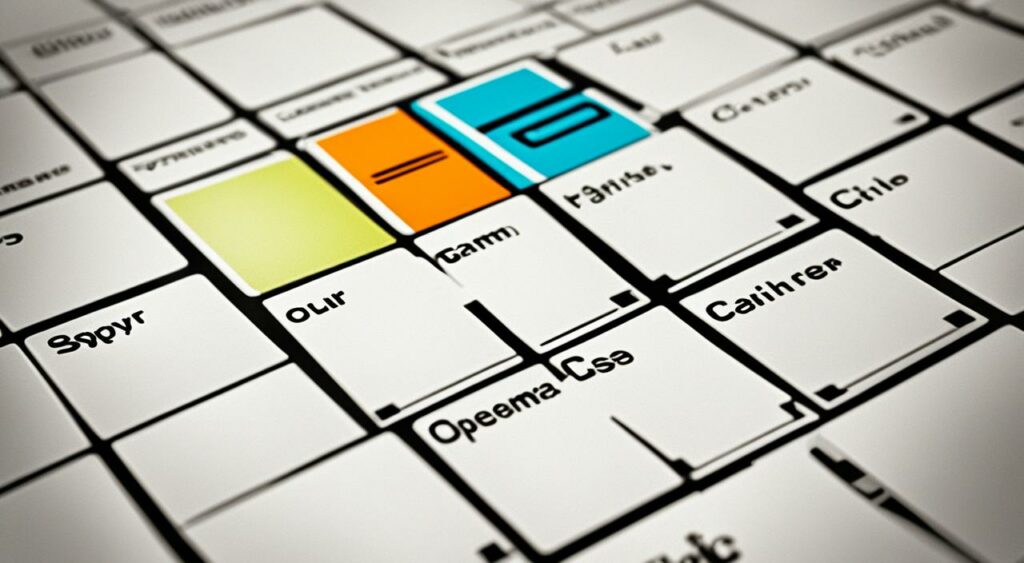Have you ever dreamed of navigating the shadowy world of spies and subterfuge? The board game Codenames invites you to do just that, transforming your tabletop into an arena of covert operations where being clever with words is your key to success. As a strategy game interwoven with elements from classic party games, Codenames offers an exceptional blend of teamwork, deduction, and quick thinking. If you’re looking to learn how to play Codenames, you’re in for a compelling experience that will test your linguistic agility and ability to connect under pressure.
In Codenames, you’re part of an enigmatic spy network, and your aim is to make contact with all your undercover agents before the opposing team does. With a mix of strategy and luck, you’ll navigate through a minefield of words, decoding information and avoiding traps set by enemy spies. The rules of Codenames are straightforward yet challenging, providing a depth of play that rewards clever strategy and strong team dynamics. Are you ready to step into the shoes of a mastermind spymaster or a shrewd field operative? Gather your allies for an engaging game night where brains meet thrill in a battle of wits.
Key Takeaways
- Embrace the role of a spymaster or field operative in this captivating strategy word game.
- Dive into quick sessions of Codenames, lasting between 15 to 30 minutes – perfect for any gathering.
- Boost your linguistic skills as you employ strategy and creativity to interpret clues and connect codenames.
- Understand the importance of teamwork as you and your allies race against opponents to contact all agents first.
- Discover the dynamics of Codenames gameplay, where every word counts and every guess can swing the tide of the game.
- Learn to play Codenames, a game that promises both intellectual stimulation and excitement, ensuring a unique party experience.
An Introduction to Codenames: The Strategic Team Game
Delving into the world of Codenames, you find a unique blend of a word game’s challenge and a spy game’s intrigue. Often considered the ultimate party game for those who thrive on strategy and teamwork, Codenames allows you to step into a realm of secret agents and hidden messages. Perfect for friends and family, this team game transforms everyone into spymasters and field operatives, engaging in a mental tug of war to unveil secret identities through word associations.
Essence of Codenames: Word Game Meets Spy Game
The foundation of Codenames is its clever integration of the word game mechanics with elements of espionage. As players, your mission is not only to find words but to uncover agents camouflaged in a grid of seemingly random words. It’s a test of wit and vocabulary, where spymasters must nudge their teams towards the right words while avoiding those that belong to the opposition, or worse, the assassin that spells instant defeat.
Cooperative Gameplay: The Heart of Codenames
Unlike games that revolve around individual prowess, Codenames is built on the power of collaboration. Here, the spymaster’s cryptic one-word clues must be interpreted by the rest of the team. This requires a deep understanding of not just the words, but of each other’s thought processes and strategies. It’s this collective effort to decode clues and reveal the correct words that encapsulates the cooperative essence of the game. As a spy game, communication is both coded and critical, while as a word game, precision and creativity in language use can make all the difference.
Whether you’re a linguaphile or an enthusiast of team games teeming with mystery and deduction, Codenames stands as an enthralling bridge between the two, ready to be the highlight of your next game night. Prepare to assemble your team, sharpen your minds, and delve into the double lives of words where every clue can lead to victory or an unexpected trap.
Preparing for Your Codenames Mission: Setup Essentials
Step into the world of espionage with Codenames, the thrilling card game that combines elements of a guessing game with the careful strategy of spymasters and operatives. The setup is a crucial phase where teams are formed, roles are assigned, and the stage is set for an exhilarating challenge of wits and words.
Laying the Groundwork: Choosing Your Teams
Before diving into the guessing game, gather your fellow players and split into two factions—the red and blue teams. A flexible team composition means you can even things out when faced with an odd number of players or choose to add an element of complexity with multiple spymasters per team.
Decoding the Setup: Arranging the Codenames Grid
Shuffle the 200 codename cards and randomly select 25 to create the game’s centerpiece: a 5×5 grid bursting with potential clues. As you organize the cards, spymasters take their position opposite their teams, ready to unveil a world of covert operatives with access to a singular key card. This card reveals the composition of the grid—differentiating between friendly agents, innocent bystanders, and the perilous assassin—a single slip could be one’s undoing within this puzzle of deduction.
Codenames Rules: The Foundation of Strategic Gameplay
Embarking on a quest for clandestine communication and subtle strategy brings you to the essence of the popular party game, Codenames. As you delve into the world where every word could disguise an ally or foe, understanding the Codenames rules is paramount. Whether you’re a beginner to this strategic game or looking to refine your mastery, knowing the rules will elevate your play and make each session a memorable battle of wits.

Strap into the role of a spymaster or a vigilant field operative as you learn how to steer through the landscape of Codenames—a thrilling party game sure to test your lexicon and strategy. The game kickstarts with the spymasters absorbing the key card; a deliberate act that sets the stage for the cryptic dance of words that follows. The spymaster’s insight ensures that each clue is a single word followed by a specific number, with the latter revealing just how many codenames are aligned with that clue.
Sleuthing through an array of word-cards strewn across the grid, a player must avoid any terms visible on the battlefield, as each word issued by the spymaster is a beacon leading teammates toward victory or toward peril. Not just any term will do, for the game forbids using any portion of the word in view or compound words from the grid. Additionally, it’s strictly prohibited to incorporate the clue’s numerical element within the verbal hint offered.
The gameplay flows in two critical phases: the providing of clues and the subsequent guessing. It’s during these turns that the agents must pierce through the subtext, joining the dots between the spymaster’s solitary word and the web of codenames splayed in front of them. Make a false move, and you could unmask an agent of the opposition or, in a fatal twist, summon the game-ending assassin.
Your path to secret agent glory rests on your ability to wield and interpret clues with finesse. Below is the structure that guides the flow of a typical Codenames round, ensuring that players are consistently aligned with the game’s strategic core—even as they partake in the freewheeling fun that defines this party game.
| Phase | Activity | Objective |
|---|---|---|
| Clue-giving | Spymaster’s issuance of a single-word clue | To subtly direct field operatives towards friendly codenames |
| Guessing | Field operatives decode and select codenames | To correctly identify all allied agents without contacting the assassin |
| Opposition Turn | The other team’s turn starts post guessing | To compete in unearthing their agents while dodging traps |
Remember, while Codenames is indeed a strategy game demanding sharp intellect and meticulous thought, it maintains the invigorating, high-spirited nature of the best party games. Immerse yourself, align with your team, and harness the rules of Codenames as you journey through espionage-laden landscapes translating cryptic messages and unveiling the hidden agents one guess at a time.
The Role of the Spymaster: Providing the Clues
In the board game Codenames, the Spymaster holds a position of great importance, responsible for creating an intricate web of clues for the field operatives. Strategically weaving their secret messages within a word’s meaning, spymasters must guide their team to victory with both cleverness and caution.
Creating Effective Clues: The Art of Reticence and Precision
Every seasoned Spymaster knows that generating effective clues is a subtle art. It’s not about showcasing lexical finesse; it’s about delivering hints that are succinct yet expansive enough to encompass multiple codenames, leading operatives to their agents without exposing the deadly assassin or tipping off the competition. A clue’s strength lies in its brevity and the ability to evoke the intended associations in the operative’s mind.
Checking and Balancing: Ensuring Fair Play
Even in the high-stakes environment of the Codenames game, fairness is paramount. To maintain impartiality, the integrity of a clue can be put to the test by seeking the opposing Spymaster’s judgment. Should a clue be ruled out of bounds, the repercussions are immediate: not only does the turn end, but the opposing team is handed the advantage—perhaps a defining moment in the game. Hence, the Spymaster’s demeanor is another layer of the game; a poker face is essential to avoid gifting inadvertent hints to vigilant field operatives.
The Spymaster’s clues are the linchpin of strategy in Codenames, a nuanced dance of words where every syllable could shift the balance of the board game’s clandestine battlefield.
Interpreting Clues: The Field Operative’s Play
Once a clue takes flight from the spymaster’s strategic perch, it falls into the hands of field operatives in the word game Codenames, initiating a critical exercise in interpretation. In this role, the operative’s play transitions from passive listening to active analysis—a phase that makes or breaks the guessing game’s success. Beyond being a mere participant, you, as a field operative, occupy a pivotal role: decoding your spymaster’s cryptic messages within the vibrant mosaic of words arrayed as codenames.
Strategic Discussion: When Teamwork Comes into Play
It is within the crucible of teamwork that the strength of a Codenames operative is forged. Here, you and your comrades collectively dissect the spymaster’s clue, each suggestion building upon the last. The group must operate as a singular entity—each operative’s insight is invaluable, with the potential to illuminate pathways to agents concealed among the grid. A diversity of perspectives fosters a rich soil for ideas to germinate and a strategic plan to bloom, yet it demands unity in the face of decision. Field operatives must converge their different thoughts into a single touch of a card to officialize a guess.
Analyzing the Clue: Depth Over Breadth
An operative’s real power is unveiled not by the breadth of words considered but the depth of the analysis applied to each potential guess. In the guessing game Codenames, hasty conclusions can cloud judgment, tempting operatives to reach beyond the spymaster’s intent—risking exposure to an enemy agent or the innocent intervention of a bystander, thereby yielding the floor to the foe. It is prudent to funnel the breadth of possibilities into a depth of investigation, ensuring that every touch of a codename card weaves you closer towards your cloak-and-dagger triumph.
In this intricate dance of codenames, words, and wit, may your play as a field operative be as thoughtful as it is decisive, embodying the subtle art of insinuating agents from a lineup of lookalike lexicon—a guessing game demanding more than luck, requiring the precision of a strategist and the insight of an insider. Risk and reward teeter on the balance of your deliberations, making your role not simply engaging but consequential in the quest for Codenames’ victory.
Understanding the Key Card: Spymasters’ Cipher
As you delve into Codenames, a captivating party game that blends word mastery with strategic espionage, the role of the key card becomes essential. For spymasters, this card is their most potent tool—a cipher that lays out the intricate battle grid of operatives hidden amongst ordinary backdrops. Mastery of the key card is the linchpin in guiding your team to triumph, thrusting you into the heart of the cloak-and-dagger drama that makes Codenames an enthralling experience.
Decoding the Colors: Agents, Bystanders, and the Assassin
Every key card drawn in Codenames presents a dynamic layout of colors, each with a critical implication for gameplay. The blue and red squares, evocative of the game’s team colors, point to the hidden allies—the agents that spymasters must signal their operatives to uncover. Among them, beige squares reflect innocuous passersby, the innocent bystanders that dot the landscape neutral. However, lurking within this mosaic is a single black square—a dire warning of the assassin. One false move here, and your mission collapses into defeat.
The Starting Team: Deciphering the Key Card’s Borders
At the outset of Codenames, the key card’s borders provide a subtle but significant hint. The border’s color reveals which team—red or blue—has the advantage of beginning the game with an additional agent, the elusive double agent. This initial advantage sets the tone for a session that is as much a mental scrimmage as it is a lively gathering around the table. The spymaster’s insight into the key card’s borders not only signals which team leads off but shapes the strategy of the game’s opening moves.

| Key Card Element | Significance | Game Impact |
|---|---|---|
| Blue and Red Squares | Represent the agents of each team | Directs operatives to target codenames |
| Beige Squares | Denote the innocent bystanders | Adds neutral spaces to the grid, increasing difficulty |
| Black Square | Marks the assassin | Introduces high-stakes risk to clue selection |
| Border Color | Indicates the starting team | Gives a slight advantage by dictating turn order |
In the end, your ability to decipher and strategize around the key card is what sets the stage for your team’s potential victory or defeat. It is not just a card; it’s the cryptic blueprint of your covert operations. Subtly guiding your team in Codenames hinges on your capacity to interpret this cipher with a blend of keen observation and strategic foresight—a true challenge for any aspiring spymaster in this exhilarating party game.
Mistakes and Consequences: Avoiding the Assassin
In the riveting strategy game Codenames, players often find themselves enveloped in a high-stakes environment where one wrong guess can change the course of the entire game. To master this game, you need to understand the gravity of certain actions, particularly the dangers of accidentally choosing the codename corresponding to the assassin. This is not just another character you stumble upon; it’s a game-ending entity that can terminate your team’s hard-earned progress in the blink of an eye. Making contact with the assassin means an immediate loss for your team, transforming Codenames into a thrilling tightrope walk of lexical precision and strategic communication.
Strategizing in Codenames is an art of balance – every spymaster’s clue and every operative’s guess needs to be sharpened to such fine points that the risk of coming into contact with the assassin is minimized. When the stakes are this high, every turn becomes a momentous decision. Check the chart below to see what outcomes your guesses can have, and note how close or how far each one takes you to either victory or abrupt defeat.
| Guess | Possible Outcome |
|---|---|
| Friendly Agent | Progress towards victory |
| Opponent’s Agent | Accidental aid to the opposing team |
| Innocent Bystander | Loss of momentum and turn |
| Assassin | Instantaneous loss |
To maneuver effectively in this strategy game and to avoid the fearsome assassin, it requires not just a keen mind, but also an understanding of your teammates’ thought processes. It calls for a deep dive into the psyche of your companions, anticipating their interpretations and reactions to your clues. The burden of clarity lies with the spymaster, while operatives must analyze with both caution and depth to avoid the lethal mistake. Yet, despite these perils, Codenames nurtures an environment where taking risks is often necessary, though it must be done with tactical foresight. Only through such careful navigation of the verbal web can your team safely sidestep the lurking threat of the assassin and find your way to a triumphant conclusion.
Towards Victory: Final Scoring and Game Conclusion
The climactic moment in Codenames draws near as teams edge closer to the endgame. Victory is in sight, and the final scoring becomes the focal point, determining the victors of this riveting team game. Scoring in Codenames is the culmination of each team’s strategy, communication, and deductive skills – the assured signs of winning Codenames. Let’s explore the tactics that pave the way to victory and how to segue into the next stimulating round.
Scoring Tactics: Ensuring a Team’s Success
Final scoring in Codenames is a straightforward process, yet charged with anticipation. Your team’s success hinges on the accurate placement of all your colored agent cards on the correct codenames. But beware, as an inadvertent brush with the assassin card means an instant forfeit, leaving your team to rue what might have been. The key to winning Codenames often lies in the intricate interplay of the spymasters’ ingenuity and the field operatives’ interpretation abilities, a symphony that when perfectly tuned, leads to the sweet sound of victory.
Encore! Setting Up for Another Round of Codenames
As one game concludes, whether in triumph or otherwise, the spirit of Codenames invites players to another round of covert wordplay and team collaboration. Setting up for a new game is seamless: switch out the codename cards and the key card to refresh the battlefield. With everything anew, players are offered a blank slate to apply lessons learned and strategies honed from previous rounds. This resetting process not only ensures a diverse gameplay experience each time but also allows players new opportunities to refine their play and possibly sway the final scoring in their favor next time around.
Conclusion
Codenames stands as a testament to the thrilling blend that a party game can achieve when it merges the realms of language, strategy, and teamwork into an experience of suspense and deduction. It’s not merely a card game; it’s a test of trust in your teammates’ intellect, a battle waged with words, and a puzzle pieced together under the ticking clock of competition. In the quest for mastering Codenames, you learn the profound impact of every chosen word and every deciphered hint, culminating in the exhilaration of moments when everything clicks into place.
As you progress through the ranks of field operatives and rise to the challenge of becoming an astute spymaster, you gain not just a game skill but a nuanced understanding of strategy and human psychology. This is the essence of what makes Codenames an outstanding strategy game—it teaches you to listen intently, speak succinctly, and think deeply. The classic version, as well as its variations, invites players to revel in an entanglement of intellect and intuition, offering a delightful challenge to all involved.
Whether gathering with friends or engaging in family game nights, Codenames provides not only an opportunity for sharp mental play but a space for social bonding. Each session beckons you into its secrets, urging you to form alliances, break codes, and sidestep dangers. If you’re seeking a party game that challenges your mind as much as it sparks camaraderie, Codenames is the pursuit for you. Embrace the covert role, decode the labyrinth of lexicon, and may your strategic endeavors lead you to a succession of hard-won triumphs against the enigmatic backdrop of Codenames.
FAQ
How is Codenames played?
Codenames is played with players divided into two teams, each with a spymaster and field operatives. The spymasters give one-word clues followed by a number that corresponds to the codenames of their agents on a 5×5 grid. Field operatives guess the codenames based on these clues, aiming to identify all their agents before the other team does, while avoiding the assassin.
Can Codenames be played with more than eight players?
Yes, while Codenames is ideal for four to eight players, you can include more players by forming larger teams. However, this might make communication more challenging but can also add to the party game atmosphere.
What is the role of the spymaster in Codenames?
The spymaster’s role is to review the key card, which shows the positions of the agents, bystanders, and the assassin, and give clues that help their team’s field operatives guess their agents’ codenames. Spymasters must be precise and clever with their clues, as they can neither speak nor react beyond giving the one-word clue and the number. Their goal is to guide their team to victory without inadvertently leading them to choose the assassin or the opposing team’s agents.
What happens if a field operative touches the assassin codename?
If a field operative touches the card with the assassin codename, their team immediately loses the game. This element adds suspense and a higher stakes feeling to each guess.
Are there variations of Codenames that can be played?
Yes, there are multiple variations and themed versions of Codenames available. Each version provides unique twists on the original game while retaining the core mechanics. You can choose from versions that are more picture-based, have new themes, or even provide a two-player experience.
How do you win in Codenames?
A team wins Codenames by being the first to successfully identify all their agents’ codenames, as indicated by their spymaster, without guessing the assassin or too many opposing team’s agents or innocent bystanders.
Is there a time limit for giving a clue or guessing in Codenames?
There is not a strict time limit included in the standard rules of Codenames for giving a clue or making a guess. Nevertheless, players often choose to introduce a timer to keep the pace of the game brisk and engaging.
Can the spymaster use part of a compound word that appears on the table as their clue?
No, the spymaster cannot use any part of compound words that are currently on the table as their clue. Clues must be unrelated in part or whole to any word visible on the grid at the time of giving the clue.
What are some strategies for being an effective spymaster?
To be an effective spymaster, you should strive to give clues that can relate to multiple codenames on the grid, aiming to cover as much ground as possible with a single clue. Additionally, considering the perspective and thought processes of your teammates will help you tailor clues that resonate with their way of thinking.
How can field operatives effectively work together to guess the right codenames?
Field operatives work effectively by discussing their interpretations of the spymaster’s clues, considering past turns, and building upon each other’s insights. It is important to listen to each team member and connect the dots as a cooperative unit, while also avoiding hasty decisions that might lead to choosing the wrong codename.

